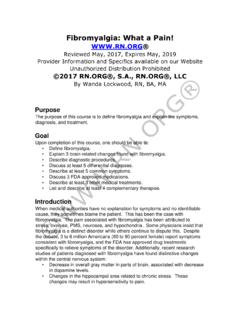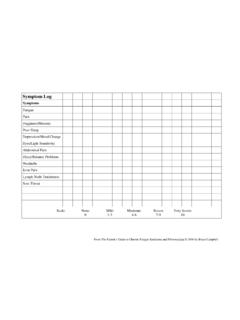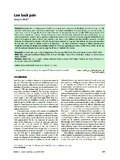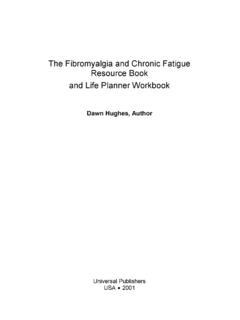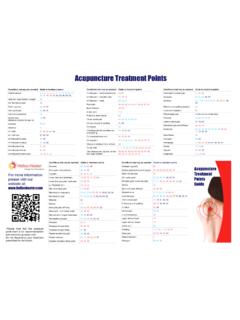Transcription of WHO Guidelines for Management of Chronic Pain in Adults
1 Scoping document for WHO Treatment Guideline on Non-malignant pain in Adults Adopted in WHO Steering Group on pain Guidelines , 14 October 2008 1 SCOPING document FOR WHO Treatment Guidelines on Chronic non-malignant pain in Adults BACKGROUND The initiative to develop these Guidelines emerged from the findings of the Delphi study conducted (1) for the Access to Controlled Medications Programme which confirmed that experts and professional bodies related to pain are looking to the WHO to take a lead in this development. These Guidelines could serve as a guide to health care professionals, policy makers and regulatory authorities for facilitating legal access and ensuring proper use of analgesics and other modalities to achieve rapid, effective and safe pain control.
2 The Guidelines will be jointly developed by the Access to Controlled Medicines Programme, the Cancer Control Programme, Management of Mental and Brain Disorders, Clinical Procedures and Child and Adolescent Health and Development. This scoping document sets out: the overall objective of these Guidelines the types of patients to whom the Guidelines apply the outcomes that are sought the proposed table of contents for the publication, and the clinical questions for which evidence needs to be sought and appraised so that evidence-based recommendations can be made.
3 The full Guidelines would be developed in accordance with the principles laid down by the WHO Guideline Review Committee. OBJECTIVES AND PATIENT POPULATION The overall objective of these Guidelines is to provide evidence-based recommendations that, if followed, will improve the pain experience of adult patients with Chronic non-malignant pain , such as low back pain , arthritis and fibromyalgia. WHO statistics show a high level of disability relating to these conditions (see table 1) although there are many more conditions which include or cause significant Chronic non-malignant pain .
4 ( Chronic pelvic pain , Chronic post surgical pain , phantom limb pain , multiple sclerosis). Although fibromyalgia is not separately classified in the WHO data, its prevalence is estimated to be between 3-6% of the world population. Some therapies which contribute to the improvement of the pain experience are beyond the scope of this document . These include specific disease-modifying therapies ( anti-rheumatic therapies, joint replacement). Scoping document for WHO Treatment Guideline on Non-malignant pain in Adults Adopted in WHO Steering Group on pain Guidelines , 14 October 2008 2 Patient population: these Guidelines address Adults and adolescents ( people aged 11-18 years) with Chronic pain related to non-malignant conditions like low back pain , arthritis and fibromyalgia.
5 Since pharmacology for adolescents is similar to adult, Management of Chronic non-malignant pain in adolescents is included in this guideline. The critical outcomes that should be considered include: effectiveness and maintenance of pain reduction, cost effectiveness, speed at which pain reduction may be achieved, effect on quality of life, effect on an individual s function, anxiety and mood, adverse effects, complications of treatments/interventions and risk-benefit analysis of interventions for pain reduction. Table 1 Disability-adjusted Life Years (DALYs) in 2002 Source: Conditions 2002 ( 000) Low back pain 2320 Osteoarthritis 14,861 Rheumatoid arthritis 4866 PROPOSED TABLE OF CONTENTS A.
6 Executive summary The objective of these Guidelines , the patients to whom they apply, the target audience and key recommendations should be stated. Acknowledgment would be included before the executive summary. B. Introduction This should include: a clear statement on the overall objective of these Guidelines and the patients to whom these Guidelines are meant to apply a statement on target audience: who will use these Guidelines - physicians, nurses, physician assistants, clinicians, specialists, general practitioners, pharmacists, caring for Adults .
7 It also aims at policy makers and programme managers, who may not be involved directly in providing care, nevertheless play an important role in ensuring care of patients a clear statement on what is beyond the scope of this document a description of the biopsychosocial context in which these Guidelines are contained - in particular the wider context of Chronic pain and the importance of holistic care of patients and their caregivers Scoping document for WHO Treatment Guideline on Non-malignant pain in Adults Adopted in WHO Steering Group on pain Guidelines .
8 14 October 2008 3 the concept of total pain based on IASP and WHO definitions including the psychological, emotional, cultural and social sequelae of living with Chronic pain over prolonged periods of time the recognition that much of pain Management can be carried out in primary care and the community, with only a relatively small percentage of patients requiring specialist pain Management the limited availability of high quality clinical trials of medicines and other therapies in Chronic pain over prolonged periods of time and the realization that many recommendations will be based on clinical experience and best opinion the effectiveness of a coordinated team approach, in its broadest sense, depending on the resources available and the setting in which pain is being managed, teams may vary in composition (different disciplines.)
9 Professions and combinations of professionals and non-professionals), complexity and size. C. Causes and classification of pain There should be a brief section (maximum one page) to state: a definition and diagnostic features of the following: o nociceptive pain including somatic, visceral and musculoskeletal pain o neuropathic pain o episodic pain o malignant vs. non-malignant pain o acute vs. Chronic pain o pain at rest vs. pain on movement o mixed pain (nociceptive and neuropathic components together) the different causes of Chronic non-malignant pain in Adults the key investigations/actors which can be helpful in distinguishing between different causes/types of pain a recognition that Chronic pain is a complex phenomenon where the intensity/ impact of the pain is not always directly related to pathology.
10 D. Evaluation of pain This should include: a reiteration of the concept of total pain a recommendation about the steps which should be taken in a holistic assessment and documentation of pain , including assessment of cause, severity, activity and sleep disturbance, mood (anxiety, depression etc) and social impact a recognition that there is a need to evaluate, measure and monitor pain and pain control and that a variety of pain scales are available though not one has been shown to be superior to others across all settings Scoping document for WHO Treatment Guideline on Non-malignant pain in Adults Adopted in WHO Steering Group on pain Guidelines .










